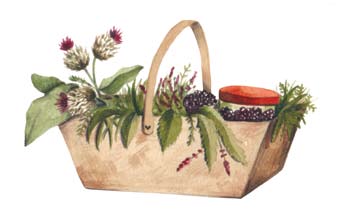Got the need to feed on the great outdoors? Check out our indispensable guide to wild edible plants
You don’t have to shell out a lot of money at the farmers’ market if you’re looking for fresh, local produce. No matter where you live, there are greens and berries growing all around you, and they’re free for the picking. If you can learn to forage—which is simply the practice of identifying food in the wild and then taking it home—you can not only save cash on your grocery bills, but you’ll also get the chance to try rare ingredients (many restaurant chefs are heavy-duty foragers) and spend some quality time with Mother Nature. There are hundreds of wild edible plants out there, but the 12 we outline here are widespread across most of North America. Even better, they have no poisonous look-alikes, and none of them are endangered species, so you’re free to munch away.
Many of the delicious plants listed here are common garden weeds, and all of them grow in cities as well as in the country. The best place to learn to identify wild edible plants is right outside your front door: you may not want to harvest that purslane growing between cracks in the concrete (hello, dog pee), but once you know how to ID it, you’ll be able to ?nd it during your next woodsy hike or stroll through a meadow. Learning to recognize even a handful of edible plants is a game changer; instead of seeing a mass of anonymous weeds, you’ll see an all-you-can-eat salad bar popping up out of the sidewalk.

Amaranth (Amaranthus)
IDENTIFYING FEATURES: Slightly hairy leaves that can be notched at the tip. Roots are reddish, and often the stems are too. Fuzzy, densely clustered ?owers and seed heads ?rst appear in summer.
HOW TO EAT: In spring and summer, amaranth leaves are terri?c cooked, tasting something like spinach. In late summer and autumn, you can remove its nutty-?avored seeds and cook them into a porridge or include them in rice pilaf.

Burdock (Arctium)
IDENTIFYING FEATURES: Circular rosettes of big (up to two feet long!) fuzzy leaves with wavy edges. Flowers are pink or purple and have the same shaving-brush shape as thistle blooms.
HOW TO EAT: Burdock’s carrot-like roots are perfect in stews and stir-fries, and the immature ?ower stalks—harvested before the blossoms appear—taste a bit like artichoke hearts. Try steaming the peeled stalks until tender, then tossing them with a vinaigrette dressing.

Common Mallow (Malva neglecta)
IDENTIFYING FEATURES: Round leaves that look like they’re pleated. Leaf edges are toothed, and pink ?owers become round seed heads that look like miniature wheels of cheese in a partially opened wrapper.
HOW TO EAT: Raw, the leaves make a good salad green; since they can be slimy (like okra) when cooked, they’re also good for thickening soups.

Asiatic Day?ower (Commelina communis)
IDENTIFYING FEATURES: Succulent stems and spear-shaped leaves with smooth edges that have sheaths where they join the stems. The blue ?owers look like miniature irises.
HOW TO EAT: The tender stems and leaves taste a bit like green beans, and you can enjoy them raw or cooked, spring through fall. The seeds are also edible—when immature, they taste like peas.
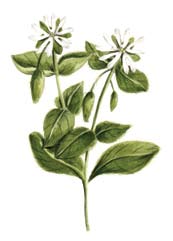
Chickweed (Stellaria media)
IDENTIFYING FEATURES: Low-growing plant with paired leaves on slender, delicate stems, which have a single row of tiny hairs running along them. Small white ?owers have ?ve petals that split so deeply, they look like 10 petals.
HOW TO EAT: Cut or break off the upper few inches of the plants and enjoy them, tender stems and all, raw or cooked. The ?avor is mild and green, like a cross between the smell of a freshly mowed lawn and the taste of lettuce.

Dandelion (Taraxacum officinale)
IDENTIFYING FEATURES: Leaves have toothed edges and grow in a circular rosette. Yellow ?owers grow on hollow, leaf-less stalks that exude a milky white sap when broken.
HOW TO EAT: In early spring, the leaves are great cooked or raw. At this stage of growth, they’re pleasantly bitter, like mustard greens. In late spring through fall, you can roast the roots in the oven, grind them up, and simmer them in water to make a caffeine-free coffee-like drink.
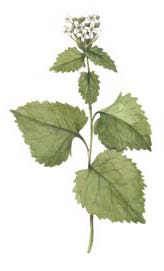
Garlic Mustard (Alliaria petiolata)
IDENTIFYING FEATURES: Lower leaves are roughly heart-shaped and grow in a circular rosette. Leaves on the ?ower stalks are smaller and triangular. Four-petaled white ?owers grow in clusters that start out looking like baby broccoli.
HOW TO EAT: Use the leaves, tender stems, and young ?ower heads the same way you cook broccoli rabe. Or put the roots in a blender for a horseradishy paste; you can also make mustard by grinding up the plant’s seeds.
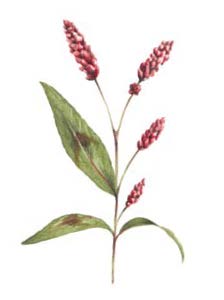
Lady’s Thumb (Polygonum persicaria)
IDENTIFYING FEATURES: Spear-shaped, smooth-edged leaves that sometimes have a dark splotch in the center. Where the leafstalks join the stems, there’s a sheath fringed with tiny hairs. The small pink ?owers look like buds about to open, (but they never do).
HOW TO EAT: Use the leaves from spring through fall in salads or mixed with other cooked greens. They’ve got a mild-yet-pungent ?avor similar to arugula.

Lamb’s-Quarters (Chenopodium album)
IDENTIFYING FEATURES: Leaves are sort-of triangular in shape, with softly toothed or scalloped edges. They have a mealy white coating (especially the smallest leaves) that can be rubbed off.
HOW TO EAT: Cooked, lamb’s-quarters leaves have a ?avor and texture very much like cooked spinach—they can take the place of that veg in any recipe.

Red Clover (Trifolium pratense)
IDENTIFYING FEATURES: Leaves have three lea?ets, each of which usually has a faint white, chevron-shaped mark. Flowers are pinkish pom-poms up to an inch in diam-eter, made up of many small ?orets.
HOW TO EAT: Strip the ?orets from the slightly tough core, and use the ?owers, fresh or dried, in baked goods and grain salads—they’re lightly sweet and add a nice spongy texture.

Violet (Viola)
IDENTIFYING FEATURES: Heart-shaped leaves with toothed margins that grow in a circular rosette. Small, ?ve-petaled purple ?owers appear in early spring.
HOW TO EAT: The mildly peppery leaves, especially the still-partially-curled younger ones, make a great salad green from early spring through early summer; the ?owers make pretty garnishes.
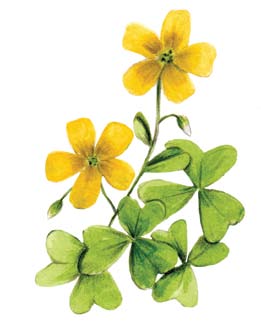
Yellow Wood Sorrel (Oxalis stricta)
IDENTIFYING FEATURES: Three heart-shaped lea?ets that remind many people of clover. Small yellow ?owers and seedpods that jut out at odd angles from stems and look like very tiny okra.
HOW TO EAT: The whole plant tastes deliciously sour and lemony and is wonderful raw or cooked. Use in salads, soups, and seafood sauces.
Tricks of the Trade:
1. Always be 100 percent certain you’re identifying a wild plant correctly before you eat it. There are field guides and foraging websites that have detailed descriptions and pictures to help you.
2. It’s easy to confuse commonly used plant names with their scientific counterparts: For example, plaintain (Plantago) has nothing do do with the banana-like fruit used in Latin cooking. So if you’ve visually identified a plant, search for it by its scientific name to be sure you’re reading about the right one.
3. Always carry a few bags or containers and a pocketknife when you’re out in nature, even if you’re not planning to forage. You never know when you’ll come across a fantastic wild fruit or vegetable and wish you had some way to harvest it and take it home! Put soft-?eshed berries into solid containers rather than bags, so they don’t get crushed.
4. While none of the plants on this list is a common allergen, it’s still possible your digestive system will be sensitive to a food you’ve never tried. Sample new-to-you
wild ingredients in small amounts at ?rst, to be sure they agree with you.
5. When you’re out foraging, store aromatic plants separately from other plants. You don’t want your spinach-esque lamb’s-quarters leaves to taste weirdly like mint.
6. Bring a water bottle and some cloth or paper towels. The water is both for your hydration and for dampening the towels. Put dampened towels into any bag containing just-harvested wild leafy greens to keep them from wilting before you get home.
—
By Leda Meredith
Illustrated by Samara Hardy
This article originally appeared in the October/November 2013 print edition of BUST Magazine. Subscribe today!
More from BUST
4 Giftable Trends for the Home: BUST Craftacular Boston
Green Your Routine: Make this Super-Simple Green Tea Coconut Body Wash
Daughters Are Prized In This Indian Village That’s Breaking Down Gender Barriers

